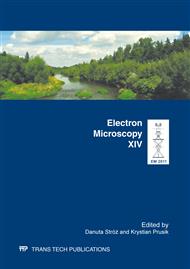p.287
p.292
p.296
p.301
p.305
p.311
p.315
p.319
p.323
Microstructural Changes Induced during Hydrogen Charging Process in Stainless Steels with and without Nitrided Layers
Abstract:
The purpose of this study is to analyze the effect of glow discharge nitriding on hydrogen degradation of two types of steels: two-phase austenitic-ferritic and single-phase austenitic. The nitriding process resulted in formation of surface layers composed of expanded austenite (S phase), and in the case of two-phase steel of expanded austenite and expanded ferrite. Microstructural changes occurring under the influence of hydrogen on steels without and with nitrided layers were investigated with the use of scanning (SEM) and transmission (TEM) electron microscopy techniques. It was shown that the density of cracks formed during cathodic hydrogen charging is higher on the surface of the non-nitrided steels compared to the nitrided steels after identical hydrogen charging process. Moreover in non nitrided steel hydrogenation leads to considerable increase of dislocation density, which results from the high concentration of hydrogen absorbed to the steel during its cathodic charging. This leads in turn to high stress concentration and local embrittlement giving rise to cracks formation. Conversely nitriding reduces the absorption of hydrogen and prevents structural changes resulting in hydrogen embrittlement. The conducted studies show that glow discharge nitriding can be used to increase resistance to hydrogen embrittlement of austenitic and austenitic ferritic stainless steels.
Info:
Periodical:
Pages:
305-310
Citation:
Online since:
March 2012
Authors:
Price:
Сopyright:
© 2012 Trans Tech Publications Ltd. All Rights Reserved
Share:
Citation:


